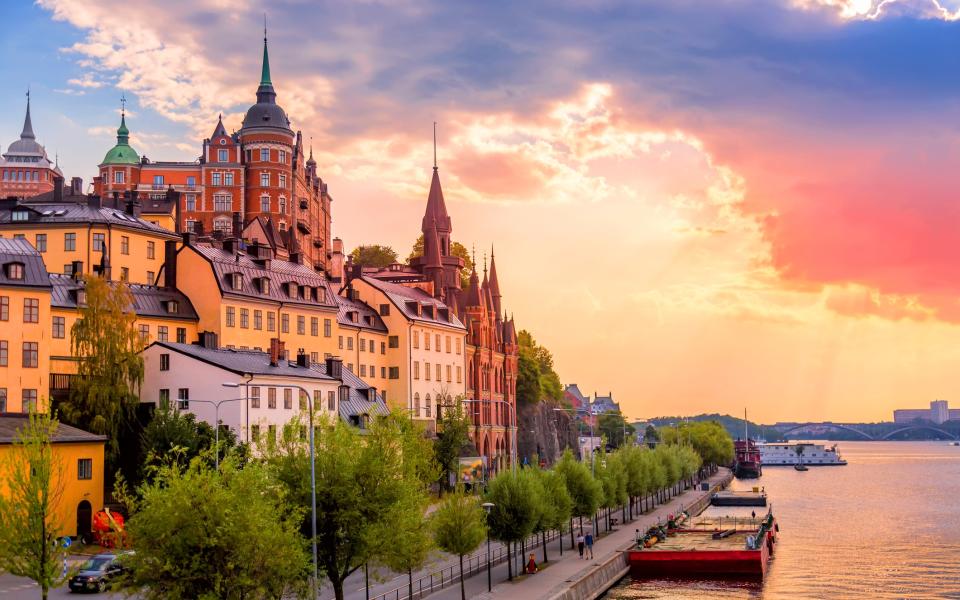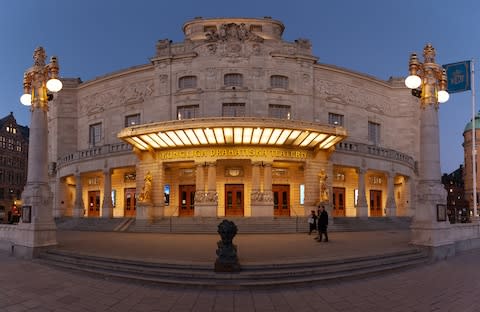The city that held the hearts of Ingrid Bergman and Greta Garbo

Just inside the reception of the Strand Hotel, a photograph of Ingrid Bergman captures a pure fragment of yesteryear.
It finds Sweden’s greatest actress, not in her most recognised guise as a screen icon, nor in a microsecond of flashbulb triumph, collecting one of her three Oscar statues – but in a moment of familial tenderness, a mother retracing her roots.
If she appears distracted, unaware of the lens, it is because she has other things on her mind. She is, in this hour, far removed from her bright-eyed star turn as Ilsa Lund in Casablanca.
This snapshot is 13 years on from that 1942 hit, somewhere in the winter of 1954-55 – and somewhere in the latter stages of her career’s own cold season. She is protected against the former by a thick coat and tight-fitting hat and insulated against the latter by the presence of her son Renato.
He is maybe five in this image, this small boy – the direct result of Bergman’s affair with the Italian director (and, by this point, her second husband) Roberto Rossellini, which scandalised America and temporarily damaged her position in the film industry. Renato grasps her right hand as he peers upwards to follow her left – which is gesturing at the building behind the camera. “This,” she is perhaps telling him, “is the Dramaten Theatre. This is where I started out."

Yet if the photo defines a moment, it also captures a place. Visible beyond Bergman’s shoulder, Nybroviken looks in the Fifties much as it does in 2019 – a doughty harbour with a ferry-boat waiting idly at its wharf, and cars inching along the road that flanks it.
Of course, there is little reason why this narrow bay would have changed much, even across the passage of six decades. It is a significant functional element of the Stockholm landscape – one which has long divided the Blasieholmen peninsula from the neighbouring district of Ostermalm.
But while there are certainly more feted locations in the Swedish capital, all within walking distance – the “Old Town” kernel of Gamla Stan, with its royal palace; tiny islet Skeppsholmen, with its Museum of Modern Art; swarthier Djurgarden, where the Abba Museum and the Grona Lund theme park tussle for visitors’ attention – there is a fair claim to be made that, in ambling along Nybroviken’s dock, you are strolling through the core of the city’s cultural soul.
And that you are doing so arm-in-arm with the ghosts of Sweden’s cinematic “holy trinity” of the 20th century – not just Ingrid Bergman, but her directorial near-namesake Ingmar, and her celestial forerunner Greta Garbo. Their tales played out here, in these few square yards – and they echo still.
Pinned to the west side of the harbour, the Strand Hotel is there in the background above Renato’s head, its distinctive brick tower pushing up into the pale sky. She loved to stay in its plush confines whenever she was in town, always cocooning herself in room 607 (now room 609) – a corner suite at the front of the property from which you can see the Dramaten. The view carried her back to her formative years. She studied at its attached theatre school in 1934 – but left halfway through her two-year course, when paid work started to roll in.

She was not the first Swedish superstar to make this proud journey around Nybroviken. Twelve years earlier, in 1922, the 17-year-old Greta Lovisa Gustafsson had enrolled at the Dramaten school.
She would thrive, being cast in her first film (Finnish silent drama The Saga of Gosta Berling) before 1924 was out, then enchanting the world under her stage name after making a graceful jump to “talkie” movies – not least Mata Hari (1931).
But before Hollywood snared her, Garbo too had tripped along the Strand’s hallways. Her association with it began as early as 1920, when her first break had come in commercials. She had been working in the millinery section of the PUB department store in Norrmalm (now the Scandic Hotel), and occasionally modelling hats for its catalogues. This low-level exposure, and her striking features, had seen her cast in fashion adverts – one of them filmed on the Strand’s rooftop.
Nearly a century on, her silver-screen aura still seems to illuminate the hotel. I first find her on the fourth floor, where she lingers, moody and beautiful, in a black-and-white still – her right hand raised to her temple. She is there too on the first floor, behind the door of Room 100.
For a while in the Twenties, this was a secret drinking den, where politicians could sip illicitly in defiance of prohibition laws. But it became one of Garbo’s places of refuge – partly because, as with Bergman in the years beyond – it looked across Nybroviken to her yesterdays at the Dramaten. Her links to the hotel were such that her ashes were kept under its eaves in the days after her death (in New York) in April 1990.

In that late-winter month, Sweden was under the thumb of weather so icy that the ground was too hard for burials. And so Garbo “enjoyed” one last stay at the Strand, while she waited for the soil at Skogskyrkogarden Cemetery, south of Stockholm, to thaw.
Originally opened in 1912, and heavily restored in the past three years, the Strand has not forgotten its best-loved guest. Its restaurant, twinkling under the LEDs that fill its tower’s hollow interior, has witnessed many celebrity episodes (like a married Ava Gardner and Frank Sinatra arguing at the bar in the mid-Fifties).
But it is Garbo who is saluted on the cover of the menu. A 1928 sketch by the artist Ernst Akerbladh puts her at the heart of the room (perhaps in 1924, before her move to the US), the eye of a social hurricane, a Dramaten after-show party swirling on either side. Next to her, her friend Mimi Pollak is an adoring acolyte – hands clasped to her chest in devotion.
Part of Garbo’s year-group, Pollak was another Dramaten alumna. If the theatre’s lustre has diminished since its school closed in 1964, it is impossible to detect this in its facade – an art-nouveau dream finished in 1908. In its grand lobby, the dark polished wood of the ticket booths competes with a blaze of gold fittings and a swoon of chandeliers to dazzle beneath the gaze of colossal statues of Comedy and Tragedy.
Pollak stepped fully out of Garbo’s shadow in this hallowed auditorium, becoming its first female director in 1948, staging more than 60 plays. It was not she, however, who opted to shut the school.

That decision was taken by Ingmar Bergman in his spell as director (1963-66) – feeling the space available had become too cramped. He would later call this move “the most stupid thing I’ve done in my entire life” – this from a man who had embraced Nazism in the Thirties (even attending a Hitler rally).
As conflicted a figure as he was, Ingmar Bergman became one of the previous century’s cultural titans, directing cinematic masterpieces such as The Seventh Seal (1957), a touchstone whose most powerful image – a chess game between a medieval knight (Max von Sydow) and the cloaked spectre of Death (Antonius Block) – is endlessly enduring. He certainly deserved better than one of his most notorious mornings at the Dramaten – dragged publicly from its rehearsal rooms on Jan 30 1976 while readying a production of August Strindberg’s The Dance of Death, on tax evasion charges that would later be dropped.
The arrest led to a period of depression and eight years of self-imposed exile in Munich – though he would later forgive his homeland. Adjacent to the theatre, the Scenkonst Museet (Swedish Museum of Performing Arts) has costumes from Bergman’s 1986 resurrection of Strindberg’s A Dream Play – staged on familiar turf at the Dramaten.
Exiting the museum, I slip into the Strandvagen 1 bar on Nybroviken’s edge. At a table in the corner, a woman, surely in her Eighties, is nursing a cocktail – her hair a shock of red even in the low light. The staff identify her as a regular theatregoer, in for her usual pre-play tipple. She is singing softly to herself as she leaves, another era’s glamour aflame. And I wonder, as I watch her enter the Dramaten, whether she sees ghosts in its doorway.
Staying there
The Radisson Collection Hotel, Strand Stockholm (Nybrokajen 9; 0046 8 5066 4000; radissoncollection.com/en/strandhotel-stockholm) offers doubles from £140, room only.
Getting there
You can journey to Stockholm Arlanda with Scandinavian Airlines (flysas.com) – from Edinburgh, Heathrow and Manchester, and with British Airways (ba.com) from Heathrow. EasyJet (easyjet.com) serves the same airport from Bristol and Luton, while Norwegian (norwegian.com) flies in from Edinburgh, Gatwick and Manchester.
Visiting there
Dramaten Theatre: dramaten.se Scenkonst Museet: scenkonstmuseet.se

